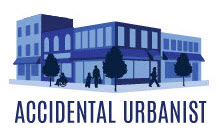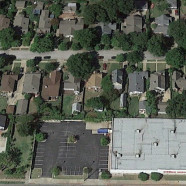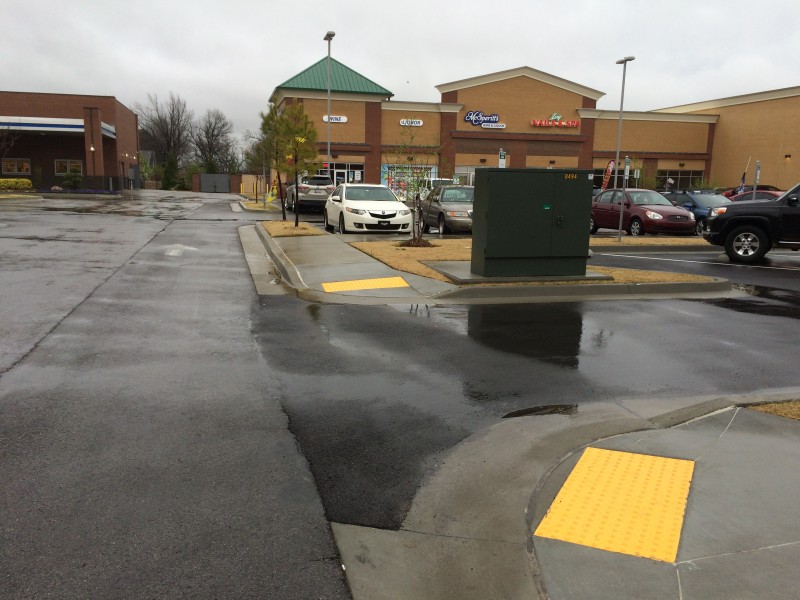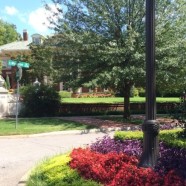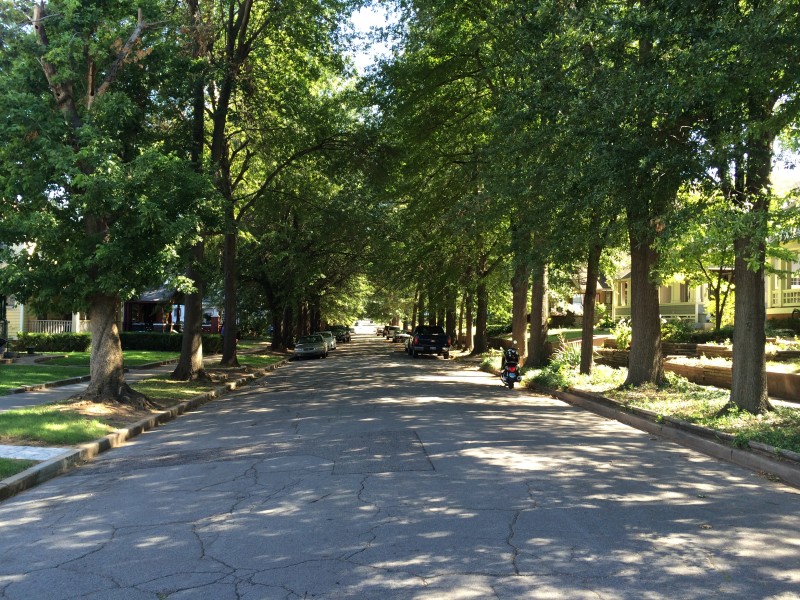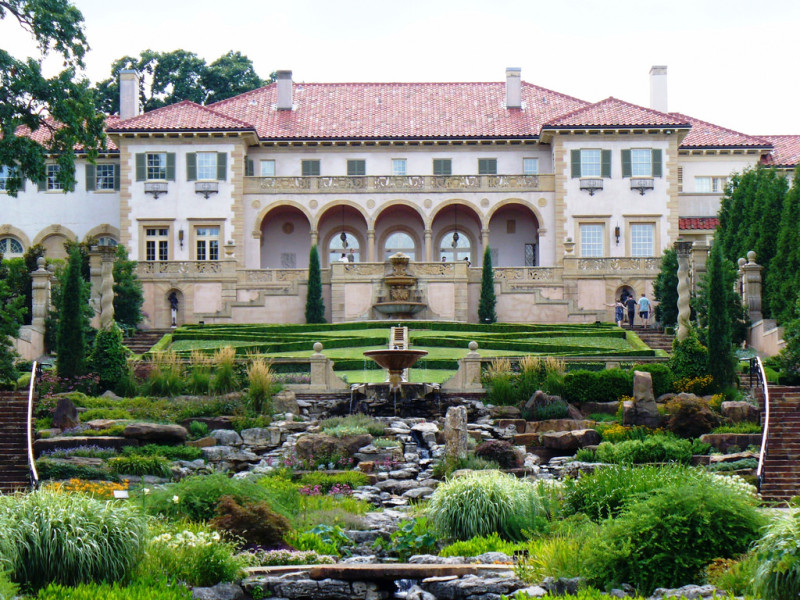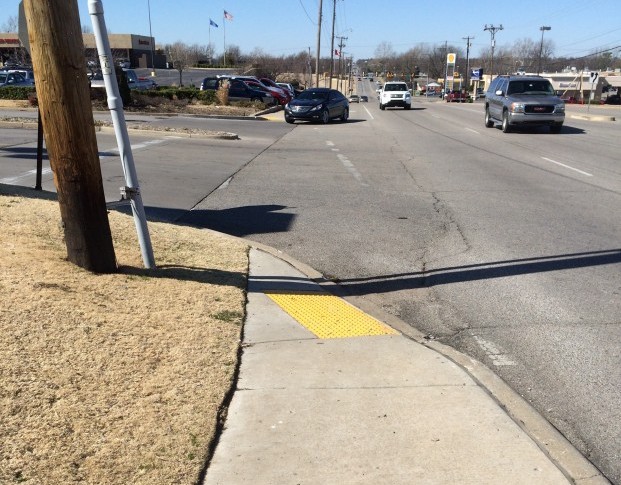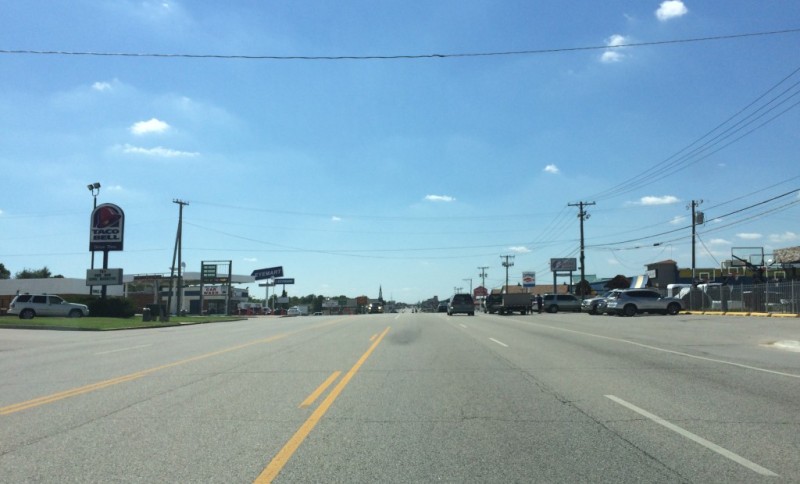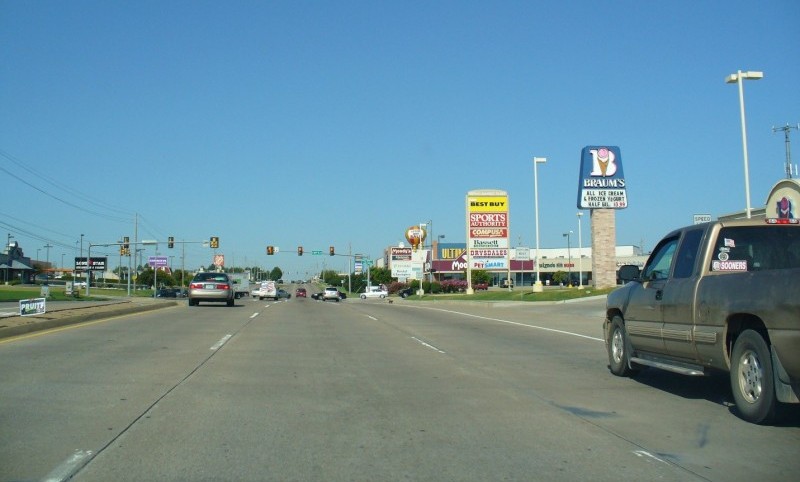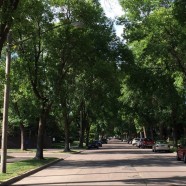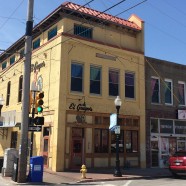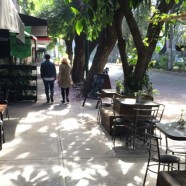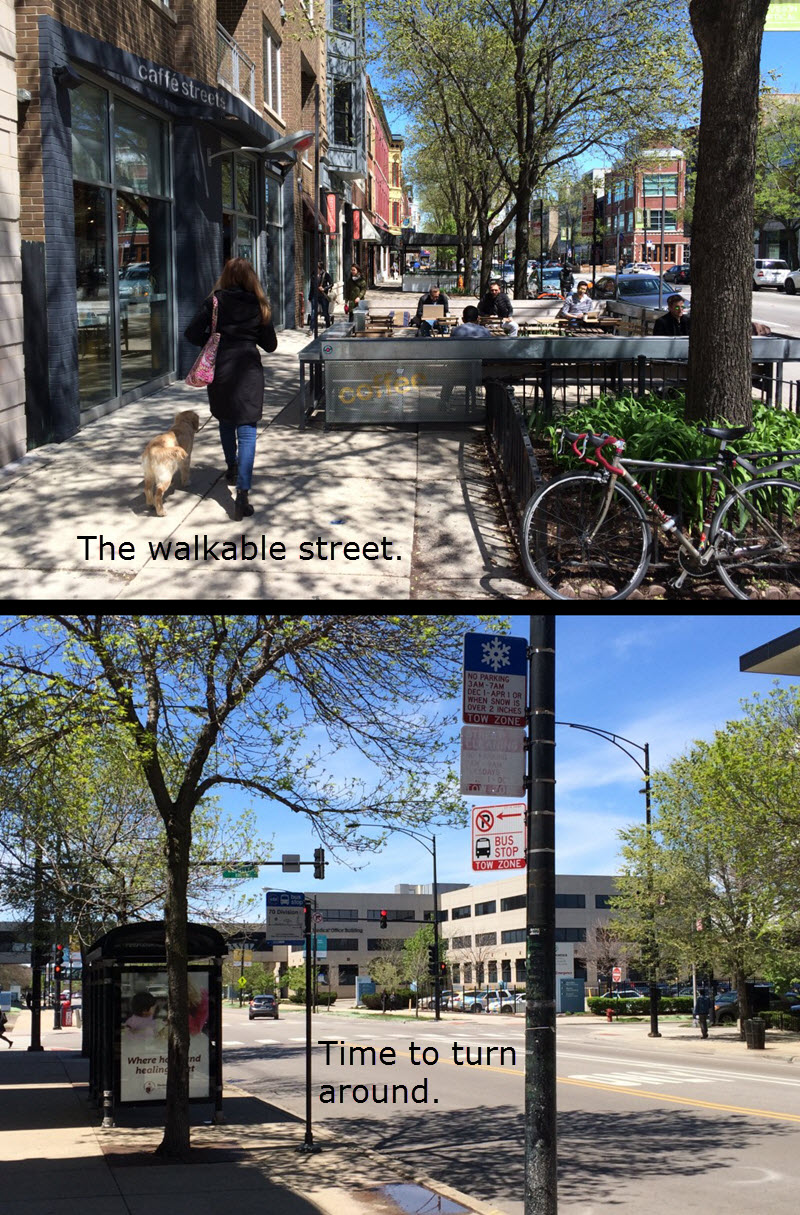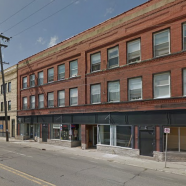Stop Shoehorning Suburbia into Walkable Places
It’s pretty easy to destroy a walkable place. We’ve been doing it for so long, it’s almost second nature. First, prioritize auto travel. Require every new building to be surrounded by lots of parking, and require every new street to be designed for high-volume, fast-moving traffic. Second, designate separate areas for people to live, work and shop, and don’t allow any of these “uses” to mingle. Third…. Well, actually, the first two will do it.
I could go on. We could talk about over-zealous fire marshals, outdated subdivision regulations that recommend cul-de-sacs instead of connected streets, federal policies that prioritize single-family suburban homes over mixed-use buildings, and inadequate transit systems. We could certainly talk about redlined neighborhoods, the Interstate Highway Act, and urban “renewal”—policies that transformed American cities like the Allied bombers transformed Dresden.
But let’s keep it simple. Over decades—one parcel and one building at a time—we have created new places where it’s virtually impossible to survive without a car, while systematically chipping away at the older places that used to be fully functioning, walkable, high-yield neighborhoods. Little by little, these once thriving areas have been degraded until they no longer work for people on foot.
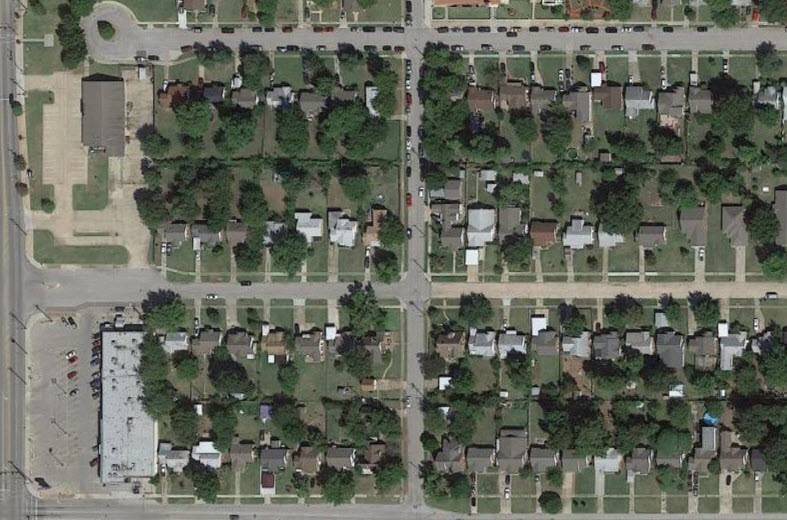
Cul-de-sacs, drive-thrus and surface parking lots are NOT what this neighborhood needs. Photo: Google Maps
OK, so mistakes were made, as the politicians like to say.
I can almost forgive the mistakes of the past. (Not the racist ones. The more I learn about the history of federal housing policy, the more it makes my head explode. I also retroactively hate everyone responsible for demolishing architectural treasures because someone wanted more parking or a building made of precast concrete. For the perpetrators of these crimes, I’m going to hold a grudge.)
But I really do believe that most people had good intentions and acted in good faith. I’m sure that for the past 70 years, most civil engineers, city planners and members of local planning commissions thought they were doing the right thing to make their cities better. All that “shiny and new” stuff probably looked pretty good at the time.
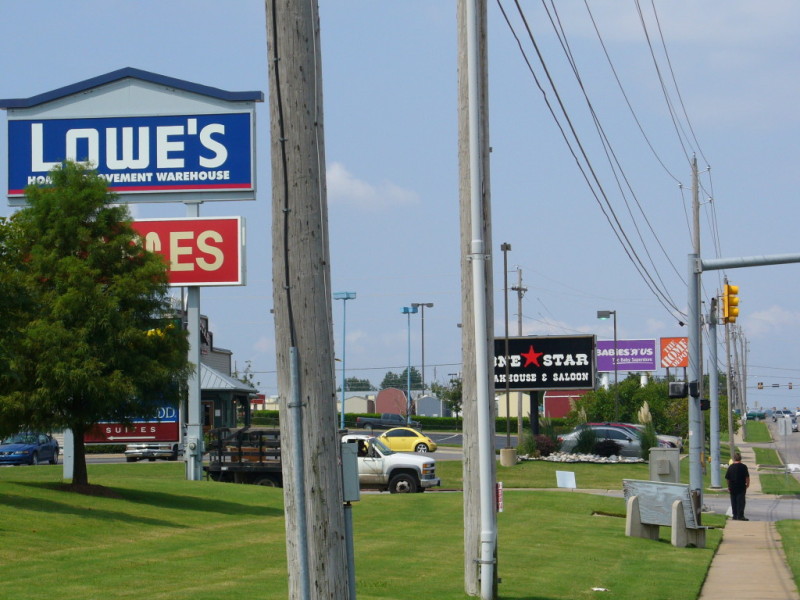
In hindsight, maybe this wasn’t such a great idea. Photo by Sarah Kobos
Fine. We’ll add suburban sprawl to the long list of humanity’s mistakes that occurred during the latter half of the 20th Century. Like feathered bangs, the Ford Pinto, or any tattoo you got before the age of 35, sometimes we err, not because of malice, but from an understandable combination of ignorance and exuberance.
The thing that really drives me crazy is the present. Now, we know better. We recognize the economic, human health, and environmental benefits of traditional building patterns. And yet, there is so much inertia built into the system, we just keep building car-centric crap like it was 1985.
Here’s the conundrum: it’s incredibly hard to insert walkable places into a car-centric landscape. In areas defined by fast traffic, wide streets, large lots, single-use zoning, and inhospitable asphalt blast furnaces, you can’t just build a nice storefront up by the street and expect it to succeed. Your otherwise perfect design will fail as a walkable place because of everything that surrounds it. You can’t grow a fern on a sand dune in the Sahara.
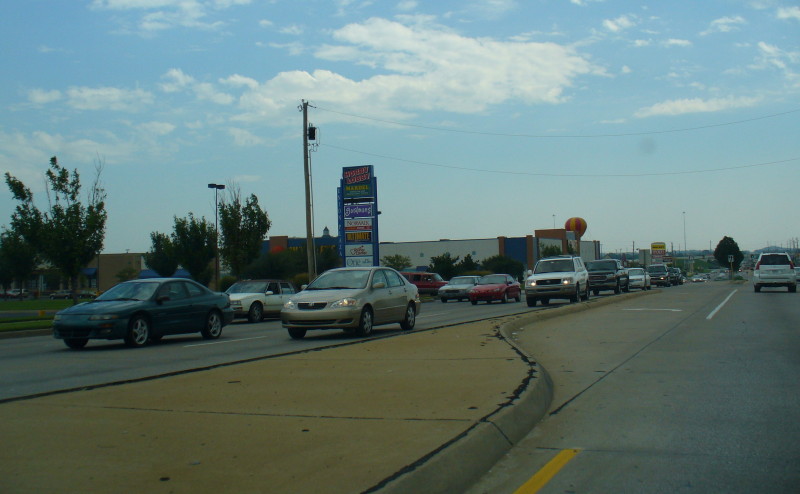
Go ahead, I dare you. Just try to build something walkable here.
But you can all too easily insert a car-centric development into a walkable area with no negative consequences (to you). Your single-use, suburban-style development will function as designed—for people in cars—operating independently from everything around it. Meanwhile, that single inappropriate project will degrade everything else in the surrounding ecosystem that makes the place desirable to begin with. It will increase auto traffic while disrupting the urban fabric and acting as a barrier to people on foot.
It’s a hard habit to quit.
In older parts of the city, walkable neighborhoods are being rediscovered and revitalized because they’re interesting, human-scaled, and pleasant. People are drawn to them because they have character, and because it’s nice to be able to walk to dinner or bike to meet friends for coffee. Understandably, the moment a particular neighborhood becomes popular—thanks to its historic buildings and traditional building pattern—it will attract new development. But if you’re not prepared with zoning laws to enhance and support walkability, you’ll get what everyone knows how to build, which is crap for cars.
It doesn’t take much to punish a pedestrian.
A blank wall, a surface parking lot, anything with a drive-thru—these all signify to pedestrians that the walkable area has ended. They are evidence that we’ve left the human realm and are now operating in an auto-only area. Our bodies respond accordingly. Like early explorers who’ve come to the end of the known world, we’re immediately uncomfortable and on guard. Most people will stop and turn around. The built environment warns us: Here be dragons.
Attention everyone: please stop building suburban crap in historic, walkable neighborhoods. Geez! You’ve got the whole rest of the city that’s perfectly designed for that stuff. Quit trying to shoehorn it into old districts where its very presence creates dysfunction for the properties around it.
Unfortunately, this is often what our zoning code requires.
Neighborhoods that were built before the advent of zoning were a mix of residential, commercial and industrial activities. When city planners were later tasked with drawing up zoning maps, they had to pick a single use, so they labeled the existing places where people lived above shops and restaurants as “commercial.”
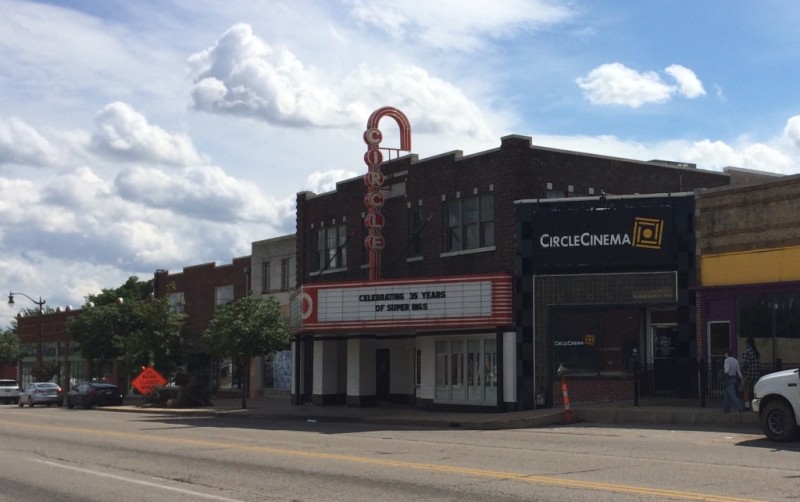
Historic Whittier Square in Tulsa, OK – Photo by Sarah Kobos
Since that time, we have gradually added requirements to our ordinances governing commercial lots. Parking per square foot of building space; percent of landscaping area; maximum floor area ratios; building setbacks, prohibitions against residential uses, and many more. But every one of these requirements was created with car-oriented, suburban-style development in mind. The zoning code didn’t support the old places built for people on foot, and in far too many cities, ordinances and zoning maps have still not been updated to protect these incredibly valuable assets.
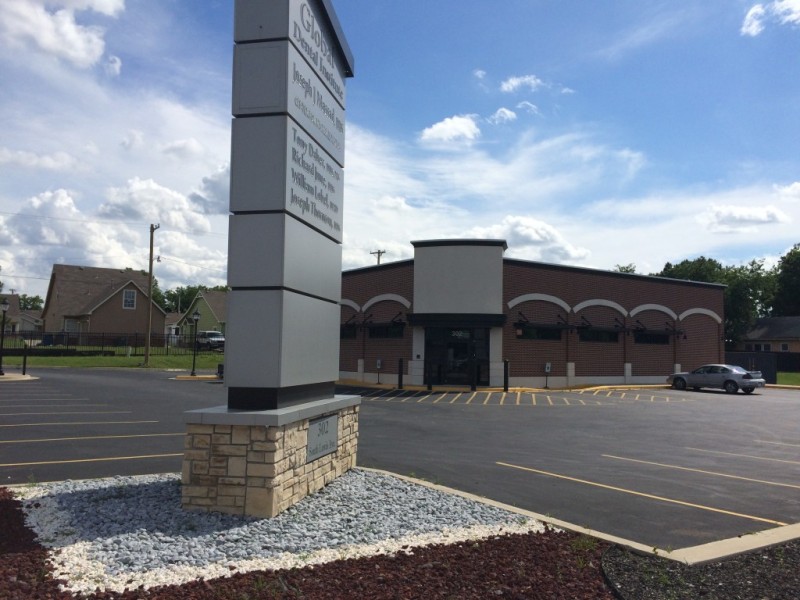
Two blocks south of Whittier Square in Tulsa, OK – Photo by Sarah Kobos
We desperately need more high-quality, walkable places, not only because people love them, but because they are revenue producers for our cash-strapped cities. Traditional building patterns utilize land and resources far more efficiently than car-oriented developments, while generating more tax revenue than they consume in public infrastructure investments.
Our best way forward is to take a step back.
Sprawl repair is complex and expensive. The challenges of transforming car-oriented suburbia into traditional walkable environments are mind-boggling. In modern suburbia, too many cards are stacked against walkability.
Fortunately, many cities are loaded with older, overlooked neighborhoods with the perfect DNA to support walkability. They have good bones, despite decades of neglect and the intrusion of too many auto-centric developments. If you need a clue, just look for places with compact street grids, houses on small lots, alleys, mixed-use streets with traditional storefronts, historic 4-plexes, etc. These are the areas of town with the greatest potential because so much is already right, and small investments can have drastic results.
All we need is the common sense to improve these areas without destroying them.
– By Sarah Kobos
(Originally published by StrongTowns.org on 5/30/17)
Read MoreWhere Every Citizen’s Heart Can Sing
As you go about your day, what do you see?
Are you fortunate enough to live on a tree-lined street, surrounded by charming architecture and manicured yards?
Can you walk to the store along interesting sidewalks where flower beds, public art, and street trees add to the delight of window shopping along your path?
Does your daily life bring you in contact with natural beauty such as oceans, scenic rivers or mountains?
If so, cheers to you.
For most folks, these experiences aren’t part of day-to-day life. They occur only on vacation, where we seek out the most lovable and beautiful destinations during a couple weeks out of the year. Of course, that’s if you’re lucky enough to swing a vacation at all. Many Americans don’t have that luxury. A full 42% of us did not take a single day of vacation in 2014. When a weekend “staycation” is all you get, the quality of your city has a dramatic impact on your quality of life.
A recent jaunt across town has me thinking about what we love (and will travel to experience) versus what we create.
I’ve been thinking about what it means to cut funding for parks to pay for cops and new road construction. What it means when you widen streets, but fail to build sidewalks in neighborhoods where car ownership is a luxury. More than anything, I’ve been pondering the words of Joe Riley, former mayor of Charleston, S.C., and his thoughts on beauty, equality and the public realm:
“Beauty has no economic litmus test. It’s a basic human need and instinct.”
Can anyone dispute that? And yet, for far too many of our citizens, the public realm is defined by crass consumerism and the lowest common denominator of construction materials and techniques.
Like many cities, Tulsa has its gorgeous neighborhoods and grand destinations. Stately mansions built by oil barons, world-class architecture downtown, the gardens at Philbrook Museum, miles of trails along the Arkansas River, and a shining Cesar Pelli-designed arena are among the places that are proudly displayed on postcards and convention bureau publications.
But what about the people who don’t live in historic neighborhoods, or have time to visit art museums, or can’t spare an extra $100 for a concert? What do we build for them?
The vast majority of our public investment in the built environment seems to satisfy only our most pragmatic needs, like patching potholes, widening roads, and updating water/sewer lines—leaving little room for beauty or grace. And while Tulsa is lucky enough to have a “1% for art” ordinance, requiring one percent of all construction costs for public facilities to be dedicated to art, this does not include road projects, where a majority of our tax dollars are spent.
But even with so much of our treasury going to transportation, our streets are not delightful. They are designed for high-speed auto travel, maximum capacity, and the turn-radius of trucks. Our street engineers are not tasked with considering the feelings of “a mother walking down the street, holding her child’s hand”—something that Mayor Riley believes should be the essence of urban design.
Instead we operate in silos. We have vision documents and neighborhood plans showing where people want to see revitalization and walkable “main streets.” We have a zoning map that was never updated to reflect that vision. We have private developers looking to maximize profits, regardless of the adopted long-range plans. And we have city engineers designing city streets to highway standards, which is exactly the opposite of what you need to create the human-scaled, walkable destinations people crave.
When I talk to folks from around the country, I get the feeling that we’re not alone. Getting everybody on the same boat, rowing in the same direction can be a challenge.
Here in Tulsa, I can’t help noticing that we’ve missed the boat in another way. When I think about cities, I’m reminded that the built environment is transformed one project and one building at a time. Over decades, cities evolve and are reborn. To repair past mistakes, it’s necessary to reinvest in older areas, always moving in the direction of a better vision, and a better quality of life for our citizens.
Thanks to an unfortunate state law, however, Tulsa depends almost entirely upon sales taxes for municipal funding. Our craving for “new” tax dollars combined with cheap land has resulted in a misguided 50-year habit of continuous greenfield development. As we have pushed new development further and further towards the south, we have often ignored the vast opportunities for re-development available much closer to the city center.
A WEIRD SORT OF MANIFEST DESTINY
As a result, new developments on the far fringes of the city include improved landscaping, buried utilities and complete sidewalks: everything that would make walking lovely, if only they weren’t designed on a scale suitable only for cars. In older areas, where adjacent neighborhoods have connected street grids and many people walk or use transit, outdated commercial and industrial areas often lack the very amenities that give dignity and beauty to people on foot.
And while we continue to incentivize millions in private investment on the fringes, much of the public realm at the heart of our city suffers. Beautifying and improving existing areas with public funding is difficult. Money’s tight. People who have to dodge potholes on their way to work tend to be less sympathetic to spending precious resources on sidewalks, street trees, benches and planters. And there are always those who argue that “niceties” are not the role of government, and that taxes should only be spent on the bare necessities.
I tend to side with Mayor Riley, who has exactly the opposite view:
“There is no excuse for anything to ever be built that does not add to the beauty of a city. Every investment in beauty yields an economic payoff. If you build beautiful places — whether they are parks, parking garages, or public housing — the land next to these places becomes more successful. They become catalytic agents to generate economic activity.”
If, as Riley says, “the public realm is the part of our city that belongs to all of us, that gives us our identity,” we’re living in a very sad time. Because most of what we build looks like this:
Which brings us back to the folks who won’t get to go on vacation any day soon. During a presentation at CNU in Detroit, Riley reflected on the role of the built environment: “We have citizens who, that’s all they’ve got. They aren’t going to go to Paris or Rome on vacation.” So we should build places where, every day, even the least among us, “can clothe themselves with peace and beauty.”
His comments have stuck with me since that day. It’s the kind of statement you can never un-hear. It’s an idea that soaks into you, and changes the way you look at the world.
What if our goal wasn’t to build the most stuff in the shortest amount of time for the least amount of money? What if, instead, our goal was to create places of lasting beauty where, every day, our souls could be nourished by our surroundings?
What if, instead of volume, we focused on quality? Instead of working to bring new national chains, what if we worked to make every existing block a better place for our citizens? What if we took the millions we spend to widen roads for people with cars, and instead invested that money in making every street a place for all. What if we truly worked to make our city “a place where every citizen’s heart can sing?”
A girl can dream, right?
by Sarah Kobos
Read MoreThe Magic of a Tree-Lined Street
It’s time to talk about trees.
Why? Because I live in Tulsa, Oklahoma, where it’s currently 96 degrees Fahrenheit with 50% humidity, resulting in a heat index of 109 degrees. This is just a scientific way to say that it’s hotter than hell-fired habaneros out there. And to be frank, nobody cares about walkable urbanism when they’re sweating through their clothes.
MAD DOGS AND ENGLISHMEN GO OUT IN THE MIDDAY SUN…
A few days ago, despite the soaring temperatures, I decided to run a couple errands. Since both trips were within a mile and a half of my house, I hopped on my bike. For the first mile or so, I was able to cut through neighborhoods where mature trees shaded my route. With the shade and a nice breeze, the ride was amazingly comfortable. “This isn’t so bad,” I thought, casually dismissing all the heat warnings I’d heard earlier in the day.
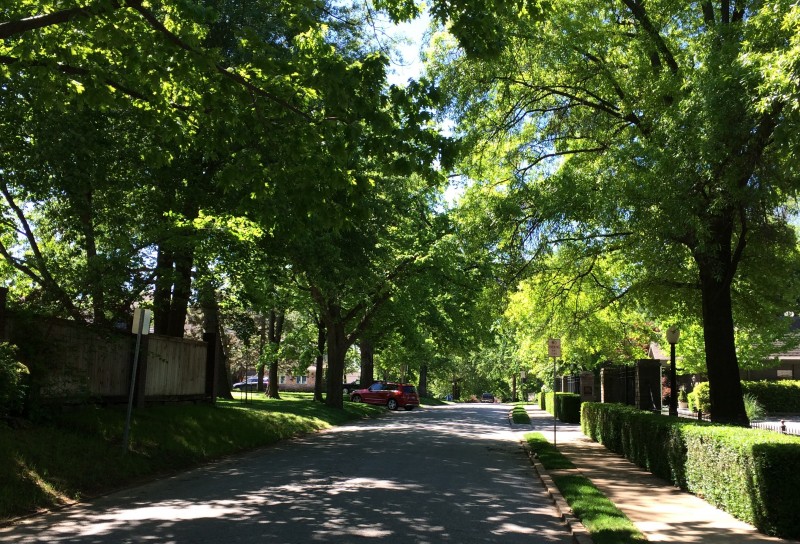
A shady street makes all the difference to cyclists and pedestrians. (Photo by Sarah Kobos)
Unfortunately, my sanguine attitude evaporated the moment I emerged from the sanctuary of a shaded neighborhood into a treeless, asphalt furnace.
No disrespect to Joan of Arc, but at least if you get burned at the stake, it’s a dry heat. This was more like being boiled. And then fried. If you built a sauna inside a kiln, it would feel something like this street.
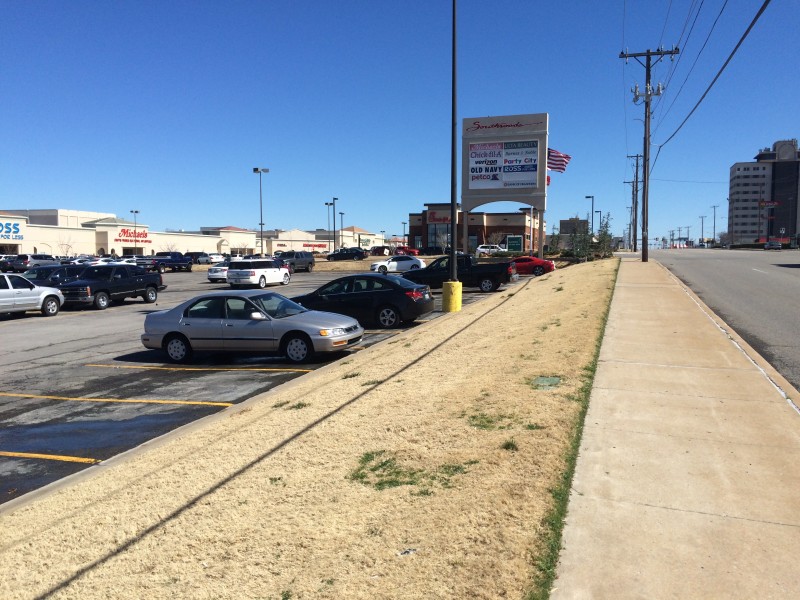
No place for humans. (Photo by Sarah Kobos)
A HOSTILE WALK ENVIRONMENT
The only thing worse than biking on a treeless street on a scorching hot day is walking on one. Since cycling creates its own breeze, you get some relief through evaporative cooling. You also reach your destination faster, which minimizes the agony. Without trees, walking along a typical city street in the summer heat is not only unpleasant, it can be life threatening.
So when you talk about “complete streets” and “active transportation” be sure to mention the importance of canopy trees. Because in a hot climate, if you don’t have shade, these options are moot. Everyone with a car is going to drive. Everyone without a car is going to suffer, or stay home.
And if you’ve never thought about street trees as a social justice issue, an afternoon spent in the summer sun walking to (and waiting for) the bus might just change your mind.
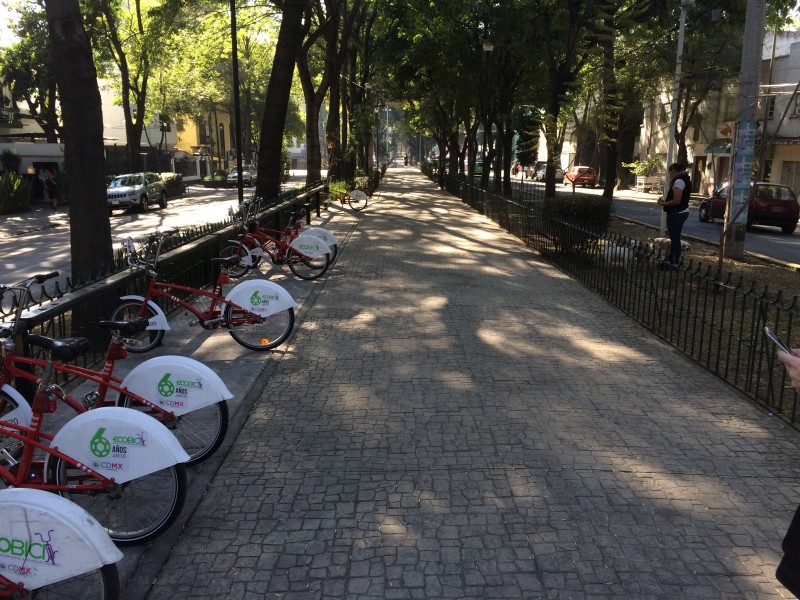
Street trees along a Mexico City boulevard offer respite from the afternoon sun. (Photo by Sarah Kobos)
Simply put, trees matter. And I don’t mean those shrubs people stick in parking lots to fulfill the landscaping requirements of the zoning code. I mean real trees. The kind that line sidewalks and create canopies over the street. The kind that turn inhospitable environments into pleasant places for people.
THE DECLINE AND FALL OF THE URBAN STREET TREE
Our ancestors, who hadn’t yet invented air-conditioning or automobiles, understood this. They knew that city building and tree planting went hand in hand. Thus, long before the introduction of zoning codes, cities passed laws requiring trees to be planted along the public rights-of-way.
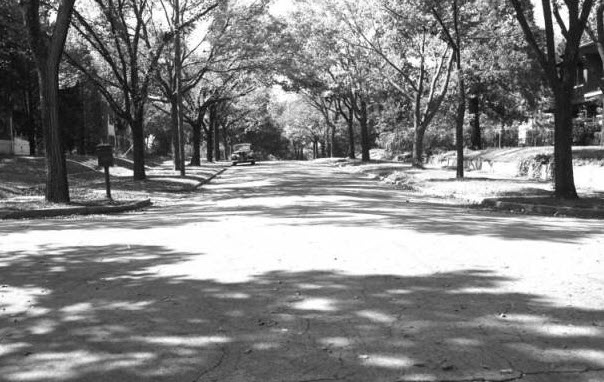
Tulsa street trees in 1950. (Photo courtesy of the Beryl Ford Collection)
Unfortunately, here in Tulsa, our urban forest has suffered in recent decades. In my lifetime alone, a number of tragic events—both man-made and natural—have decimated our once dignified tree-lined streets. Dutch Elm Disease, wind storms, ice storms, and butchering by unqualified tree-trimmers—many hired by the local electric company to protect power lines—have destroyed countless thousands of mature trees throughout the city.
Not everyone has re-planted. Many people simply don’t relish dealing with them after the expensive ordeal of removing massive downed trees from their property. (I don’t know if a tree makes a sound when it falls in the forest; but when it crushes your roof, it leaves a lasting impression.) Some can’t afford the luxury of replanting. Others, like many rental property owners, just don’t bother. And those with the inclination and financial resources to replant may select an inappropriate species or ineffective location for their replacement trees.
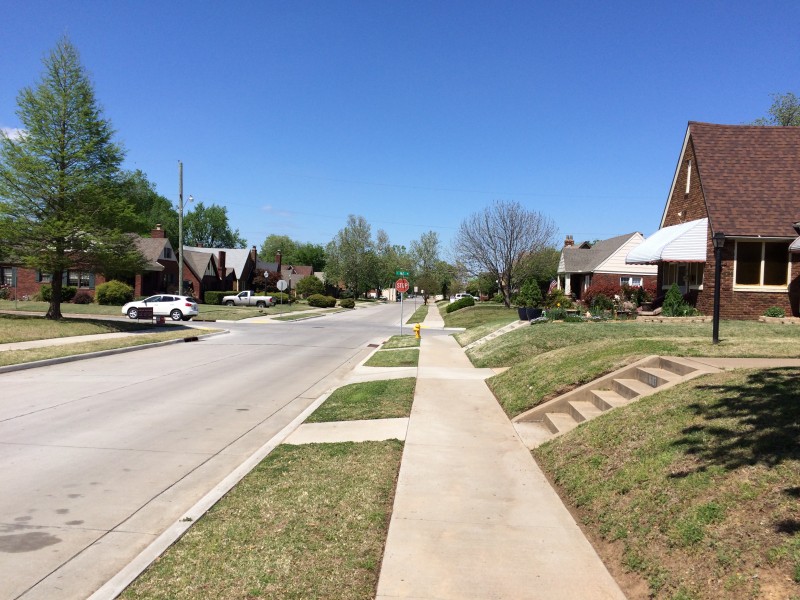
A neighborhood looks naked without street trees. Photo by Sarah Kobos
When it comes to creating tree canopies, many obstacles are enshrined in public policy. Zoning codes apply to private property, not the city’s right-of-way, so required trees are often set back too far from the street to create a pleasing pedestrian environment. Engineering standards require clear sight lines next to the road, which prevents street trees from being located where they are most effective. And the local power company recommends planting short, ornamental trees near power lines, which, all too often, are located along arterial streets. Together, these rules eliminate the possibility of creating or restoring a tree canopy that would benefit pedestrians and cyclists throughout the city.
BEYOND PEDESTRIAN COMFORT: STREET TREES AND THE BOTTOM LINE
We have a long way to go to replace what has been lost. But we have to keep working because street trees make places more walkable and bikeable and beautiful. All of which should be reason enough to fight for better streetscaping.
But there are myriad other ways in which street trees benefit cities and individuals alike. Among the most important to municipalities are significant reductions in stormwater runoff; improved air quality and reductions in greenhouse gases like ozone and carbon dioxide; improved pedestrian and driver safety; and higher taxes resulting from increased property values and commercial sales.
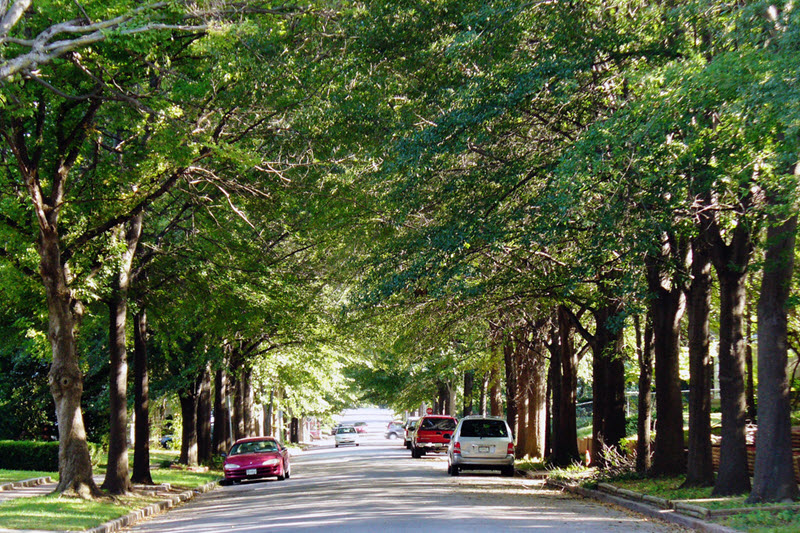
Street trees working their magic in Tulsa, OK. (Photo by Daniel Jeffries)
To achieve these benefits, we need to take trees seriously. Especially in urban areas, you can’t just stick a tree in the ground and expect it to prosper. For cities interested in maximizing their return on investment of street trees, the EPA has created a guide focused on design considerations that will allow street trees to survive and thrive well into maturity.
Whether you care about the environment, energy savings, property values, public health, or your city’s bottom line–plant a tree by the street. You’ll make sweaty cyclists and pedestrians happy for generations to come.
by Sarah Kobos
Read MoreKey to Education Funding: The Ground Beneath Our Feet
If you care about Tulsa’s future, you care about public education. Having watched in awe as our state legislature convulsed to the end of yet another cringe-worthy session, one thing is certain: education funding is obviously not the top priority of those in control at the capitol.
So what can be done? Let’s talk about what we can achieve at the local level, without ever taking a trip down the turnpike.
If you look at the Tulsa Public Schools budget, you’ll notice that, while state funding is certainly important, TPS actually receives slightly more revenue from local property taxes than we do from the state. In the most recent Budget and Finance Plan for the 2015-16 school year, ad valorem taxes contributed $157,205,576 to total appropriated funds, compared to $155,921,101 from the state.
What this means is that that every residential and commercial property in town generates tax dollars that benefit public schools. The higher the value of the improvements on your land, the more you pay in taxes.
If that makes you cranky, remember this: public investment in roads, water lines, sewer systems, police, fire fighters, and an educated workforce give value to your private land. Public investments act like fertilizer that allow private development to grow and prosper. In return, private entities are taxed on the value of their property to help fund critical community needs like public education, technical training, libraries, the Tulsa County Health Department, and county government.
This is the handshake of community: everyone contributes and everyone benefits.
Each year, when you pay your property taxes, you are investing in the success of Tulsa and its citizens. You’re either paying it forward, or paying it back. Either way, cheers to you!
But back to our underfunded public schools, and the grim realization that a 4-day school week is not outside the realm of possibility in our near future.
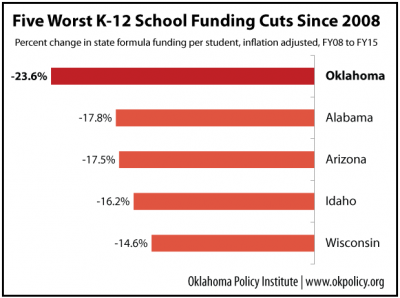
There’s Reason for Hope
Despite this shocking statement, I remain optimistic about the future of education funding. Tulsa has an ace up its sleeve that we’ve ignored for more than half a century, and it’s time we played that card. I’m talking about the land on which our city is built, and the fact that we have not come close to maximizing its value. (Don’t worry: I am NOT talking about turning park land into shopping centers!)
For clarification, let’s pay a visit to El Guapo’s Cantina.
In case you don’t know, El Guapo’s is one of several homegrown hits created by local restauranteur Elliot Nelson and The McNellie’s Group. It’s a Mexican restaurant that contributed to the rebirth of downtown Tulsa while celebrating Taco Tuesdays, rooftop dining, and surprisingly potent margaritas. They have two locations: the original one downtown, and a new south Tulsa restaurant at 81st and Harvard.
As it turns out, these two locations can teach us a lot about Tulsa Public Schools’ bottom line.
Doing the Math
First, we have El Guapo’s downtown, located on the southwest corner of 1st and Elgin. Built in 1912, this building occupies a typical 25 x 100 downtown lot, filling the entire 2,500 square foot parcel with a two-story building and a cool rooftop patio. According to the tax assessor’s website, the building contains 5,000 square feet of air conditioned space and pays annual property taxes of about $12,029. This means that every square foot of land associated with this modest building generates $4.81 in property taxes per year.
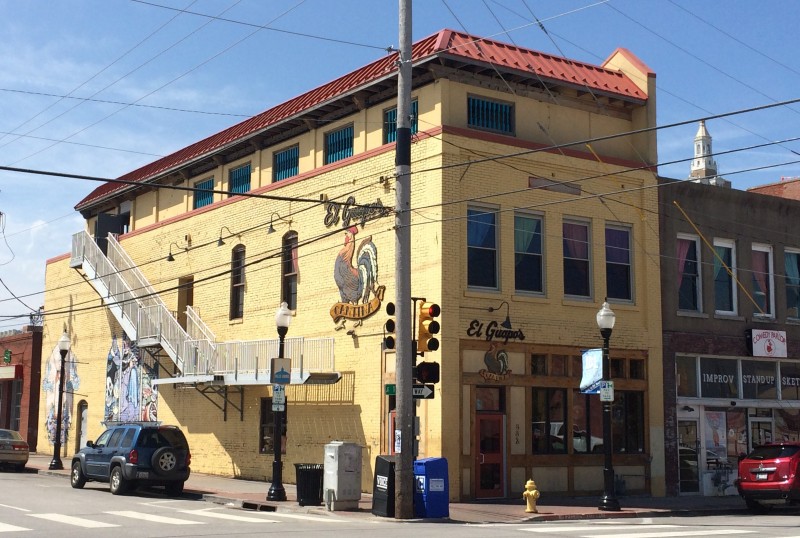
El Guapo’s downtown location – built in 1912
Next, we have the south Tulsa location near the southeast corner of 81st and Harvard. Built in 1979, this single-story building occupies 10,487 square feet of its 75,039 square-foot parcel. The remaining space (64,552 square feet) is dedicated to parking and landscaping. The entire parcel generates $15,899 in property tax revenue each year, which equals about $0.21 per square foot of land.
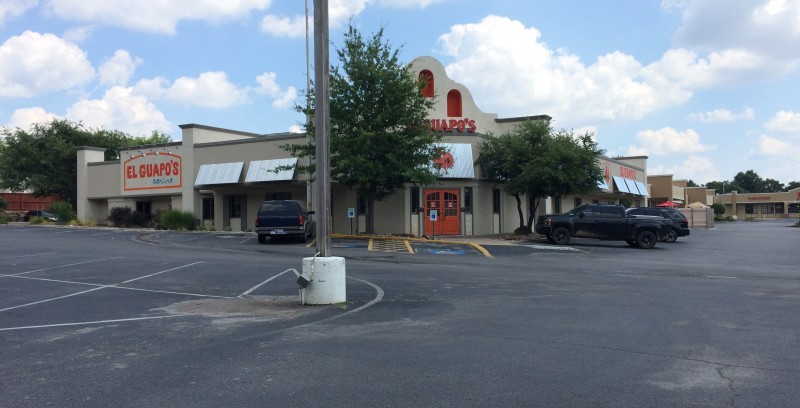
El Guapo’s south Tulsa location – built in 1979
To put this in perspective, El Guapo’s downtown generates approximately 23 times the amount of property taxes per square foot of land than the one located in a highly desirable south Tulsa location.
Have I got your attention yet? Educators… are you doing the math?
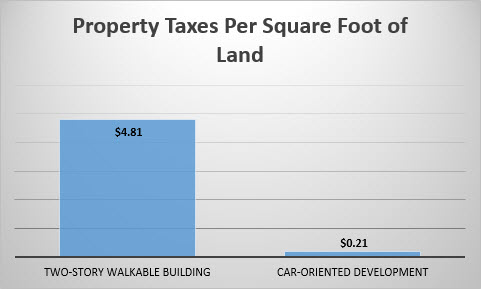
Sure, some of the difference is based on the relative value of downtown land, which can add a 40% premium over a similar parcel in the burbs. But that doesn’t explain the more than 2,000% premium on ad valorem taxes that we’re getting at the original El Guapo’s.
What really matters is how efficiently we’re using that space.
Walkable Places Generate More Taxes
Back in the day, people walked—and cities were built to accommodate this basic form of transportation. Blocks were smaller and parcels tended to be long and narrow, which allowed you to fit a lot of storefronts along a single block. Multi-story buildings were built up to the sidewalk, with doors and windows facing the street. All of this made it incredibly easy to walk from place to place, and people could live, work and shop within a compact area.
This development pattern was not only great for pedestrians; it was great for the city. The efficient use of land meant that it generated far more tax dollars than it cost to support. Tax revenue from these compact, multi-story buildings easily paid for the associated public services and infrastructure: roads, water, sewer, stormwater, police, fire, and—yes—schools.
Development patterns changed after World War II, when a combination of government policies (everything from local zoning codes to federal mortgage insurance regulations) incentivized suburban growth, while making old-fashioned, walkable places nearly impossible to build.
As the city spread out, zoning prevented us from mixing residential and commercial uses. People lived far from where they shopped and worked, driving became a necessity, and parking lots became the primary architectural feature of our city.
Too Much Parking Dilutes Revenues
Take another look at the two parcels our restaurants occupy. I’ve superimposed the downtown building onto the suburban shopping center to make it easy to visualize. (Scale is the same.)
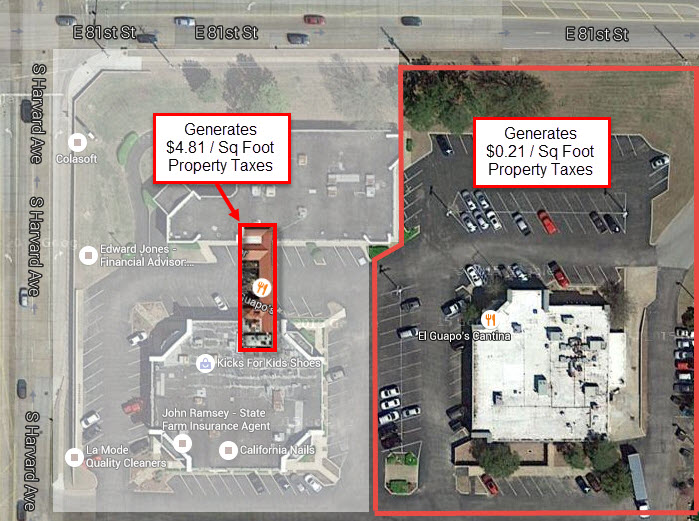
Comparison of traditional commercial building to modern shopping center.
El Guapo’s south includes dedicated parking for about 100 cars. El Guapo’s downtown includes space for zero. Amazingly, the downtown building is little more than one car-length wide. In fact, if the building were a parking lot, it could hold eleven cars.
I’ll let that soak in for a moment. Eleven cars.
In downtown Tulsa, there are no requirements to provide dedicated off-street parking. Instead, customers who drive rely upon hundreds of available parallel-parking spaces, nearby parking garages and shared parking lots. A growing population of downtown residents walk to dinner, and more and more people are choosing to bike. The building is also located close to several transit routes. This is a much more efficient system that allows people to choose their mode of transportation. At the same time, the market determines how much parking is needed, and includes the flexibility to allow spaces to be utilized both night and day by different users.
In the suburban model, every “use” provides its own dedicated off-street parking. Major streets are designed for fast moving vehicles, which doesn’t allow for on-street parking. And the buildings themselves are designed to be accessed solely by automobile. They are built on huge parcels of land, pushed back away from the street, and separated from the sidewalk by expansive parking lots.
This is great if you want to drive, but unfortunately, this single-purpose design limits our ability to utilize modes of transportation that would allow us to maximize the value of our land—and, thus, our tax revenues.
If You Care About Education Funding, You Should Care About Walkable Places
Because El Guapo’s downtown has two floors and a rooftop balcony, it functions as a 3-story building. It essentially occupies 300% of the land it sits on. Because the suburban site is a single-story building surrounded by parking, it occupies 14% of the available land. This makes a big difference to the tax assessor.
Which is why it should matter to you.
If you live in the Tulsa Public School district, about 50% of your property taxes go to support your local K-12 schools. Thus, if we want to raise an additional $50 million dollars for Tulsa Public Schools through ad valorem taxes, we would need to add about $100 million in taxable value to the land within our school district’s boundaries.
As shown above, the car-centric model of commercial development yields about $0.21 of property taxes per square foot of land, while an old-fashioned, walkable, two-story building generates about $4.81 per square foot. If we continue building our city like we did at 81st and Harvard, it would take 17 square miles of new development to increase our TPS budget by $50 million. However, it would only take ¾ of a square mile of dense, traditional, walkable buildings to achieve the same $50 million increase. (And that’s only considering 2-story buildings. Now imagine the multiplier if we built 3-story buildings!)
Think about that. Everyone can picture a square mile, because Tulsa is laid out on a grid. For example, 17 square miles would cover everything from 11th to 51st and Peoria to Sheridan, plus one more square mile thrown in for good measure. By contrast, three quarters of a square mile can be envisioned as 4th to 11th and Peoria to Delaware Ave.
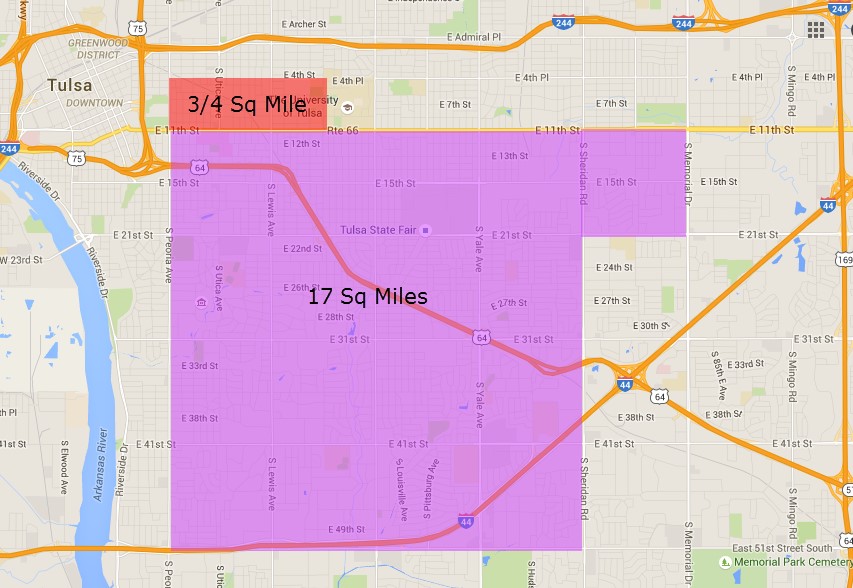
The amount of new land required to add $50 million to the education budget. Red shows traditional, walkable development. Purple shows car-oriented development.
Which option seems more realistic?
If you add up all the empty lots and under-utilized parcels of land in Tulsa, it’s easy to envision adding ¾ of a square mile of old-fashioned, high-quality, walkable infill throughout our city. Adding 17 square miles of car-centric development? Not so much.
We Need More Walkable, Bikeable, Transit-Friendly Places
If we want to solve our education budget crisis, the answer doesn’t lie solely in Oklahoma City. In fact, it’s right here in Tulsa, literally at our feet.
Building places that are conducive for walking, biking and transit is not just a good idea because people love them. It’s a moral imperative. Too much asphalt dilutes the value of land, and puts our schools in the red. A return to the traditional development patterns of the past will be the key to Tulsa’s future.
Some Good Things Are Already Happening.
For the first time in decades, Tulsa’s updated zoning code allows the possibility to create traditional, mixed-use, walkable places. In approving the recent Vision initiative, voters also supported a dedicated source of funding for transit. There’s also growing support for protected bike lanes and improved pedestrian infrastructure, along with a surge in ride share programs like Uber and Lyft. All of these are critical elements that will allow Tulsa to grow and increase our tax base without the downside of inefficient, car-centric development patterns.
But the status quo is a powerful force that will continue building wasteful sprawl unless we fight for change.
So whenever you see a vast, underutilized parking lot, you are looking at Tulsa’s future. Either we will continue to squander this land and the chance to fully fund public education, or we will return to our traditional roots, and build places that are great for people–and our schools’ bottom line.
by Sarah Kobos
Read MoreWhat We Know in Our Bones
Walkability is something we understand in our bones. If you feel comfortable and happy on foot, congratulations! You’ve just discovered a walkable place.
The same is true of places that are hostile or unwelcoming to pedestrians: we respond instinctively and are physically repelled by these places. If you’ve ever been walking down a lively street, but stopped and turned around when you came to a blank wall, a drive-thru, a parking lot or other dead spaces, then you’ve experienced it too.
Like Justice Stewart’s famous quote about porn, walkability can be hard to define, but “I know it when I see it.”
We all do.
Read MoreParking Vs. The Walkable Building (The Developer’s Dilemma)
John Anderson (R John the Bad, if you read his blog) is a guy who spent years trying to convince developers to care about walkable urbanism. As it turns out, the “brain damage” wasn’t worth it. A better approach, he decided, was to teach urbanists how to be developers. Which is how I met him last summer at the Congress for New Urbanism’s “Rookie Developers Breakfast.”
I wasn’t the only wannabe who showed up. Overwhelming interest in the topic inspired the creation of a Facebook group called Small Developer / Builders and a series of “Small Developer Boot Camps” led by John, Monte Anderson, and other members of the Incremental Development Alliance.
The lessons they teach would make Jane Jacobs dance on the sidewalk. Start small, keep it simple, build incrementally, foster local tradesmen, provide places for entrepreneurs, take the long view, invest in your neighborhood, and improve it one building at a time.
With each project, you enrich the soil of your “farm,” making the entire area more desirable and livable for you and all your neighbors. Monte Anderson, who has worked this sort of magic in his hometown of Duncanville, TX, calls it “gentle-fication,” a process that brings the community up with you in a gradual and sustainable way.
If you’re a regular Strong Towns reader, this probably makes a lot of sense. After all, this is how cities were traditionally built. People invested in the communities where they lived. Owner-occupants made incremental improvements with the expectation that their legacy would provide lasting value over time. It was never about making hedge fund investors rich from 3rd quarter profits of commodified real estate packages.
This return to an old-fashioned ideal is one of the things that makes small-scale development so appealing—especially to folks like me who care about good urban form, walkable places, and revitalizing neighborhoods. With low overhead and smart choices, it’s actually possible to build desirable places that normal people can afford. These projects help provide crucial “missing middle housing” that the big developers with their high overhead costs simply can’t deliver.
As John Anderson likes to say, “If you’ve ever found yourself eyeing an empty lot and thinking ‘Somebody ought to…’ Well, maybe that someone is you.”
IMPORTANT LESSONS FOR THE SMALL-SCALE DEVELOPER
But there are a couple important lessons that every starry-eyed dreamer/developer must consider.
First and foremost: if you can’t get the rent, you can’t build the building. So when calculating whether or not a project will “pencil,” you start with average rents and construction costs for your area, and work your way backwards to see what’s feasible. Everyone has sexy dreams, but as a developer it’s important to maintain a long-term, monogamous relationship with math.
The second lesson? “Keep it simple.” This encompasses everything from using commonly available construction materials to taking advantage of FHA loans. It also applies to site selection: whenever possible, you want to build “by right” on land that is already zoned for what you want to do.
Unfortunately, this is where a terrific aphorism crashes headfirst into the painful rock face of reality. Because most local zoning codes are ideally suited to building car-oriented crap, they are perfect for folks who like to transform large parcels of land into parking lots, shopping centers, and chain restaurants with drive thrus. Far too often, they conflict with the type of small-scale, walkable places our ancestors would recognize as home.
In cities throughout America, the places we love the best are often illegal to build. If you don’t believe me, test out your hometown zoning code by “building” a project on paper.
KICKING THE TIRES OF YOUR LOCAL ZONING CODE
That’s exactly what we did at a recent Small Developers Boot Camp in Bentonville, AR. We were given a portfolio of development opportunities taken from real life in Kalamazoo, MI. Our package included descriptions of various lots with prices based on comps; a market study of rental rates for commercial and residential spaces; average construction costs per SF; the current zoning for each parcel; and a “plain English” summary of the applicable zoning code requirements. Thus, we were able to compare lots while taking into account market realities and the nitty-gritty zoning requirements that can make or break a deal.
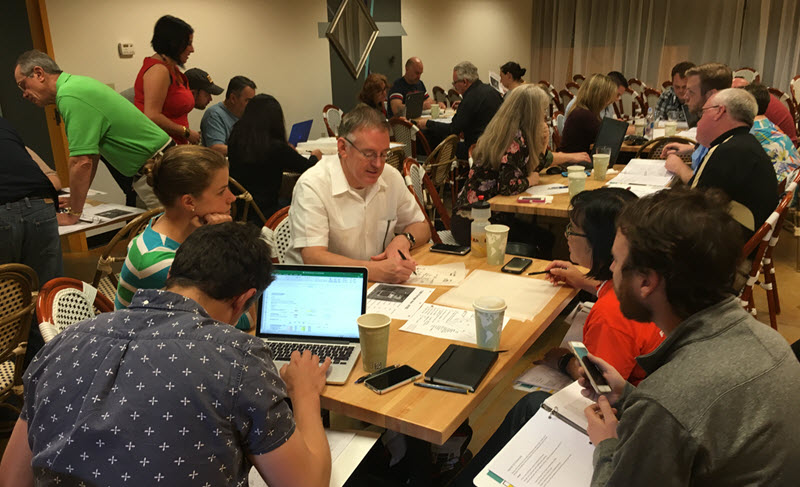 Our mission: Decide what we wanted to build, pick an appropriate lot where we could build it by right with current zoning, and use a pro forma to check the math and see if the project makes money.
Our mission: Decide what we wanted to build, pick an appropriate lot where we could build it by right with current zoning, and use a pro forma to check the math and see if the project makes money.
As aspiring small developers, we first looked for affordable, modest-sized lots, where adding a single building would help complete a missing piece of the neighborhood puzzle. This allowed us to quickly reject big, expensive parcels that were beyond our means.
A glance at the zoning code helped us dismiss other locations.
We wanted the option to build residential over commercial, but this was not allowed in several of the purely residential zoning districts. Minimum Lot Area Per Dwelling Unit (basically, how much land you need per residential unit) and setback requirements (how far back from a lot line you have to build) further limited our choices.
THE DEVIL IS IN THE DETAILS. IT’S ALSO IN TABLE 4.1-A OF YOUR LOCAL ZONING CODE
I have to say, the Minimum Lot Area requirements surprised me the most. We envisioned a compact, mixed-use building with up to three stories and six dwelling units combined with ground-floor retail. But even in a traditional neighborhood where the existing building stock matched our vision, we were limited to three residential units because of this arbitrary restriction.
We would have loved having those extra units, and I’m sure Kalamazoo would have appreciated the extra property taxes our ideal project could have generated—but the code said “no!” (Take that, local schools!)
Ultimately, we decided to test a two-story, mixed-use building with residential above retail, just like the adjacent older buildings, but smaller. For the purpose of our quick estimate, we assumed we would build three 800 SF residential units above 2,400 SF of commercial space on the ground floor, which could be divided into two or three separate storefronts if desired. It wouldn’t maximize use of the space, but it would fill in a “missing tooth” on what was once a lively, walkable street.
PARKING V. BUILDING
Next came off-street parking requirements–and the audible groans and outcries of our merry band of aspiring developers. The parcel we selected was zoned “Commercial Neighborhood” which included a lovely statement of intent: “to promote pedestrian-oriented development” and“encourage small-scale retail sales and personal services to primarily serve nearby residential neighborhoods.”
Of course, nothing says “pedestrian-oriented development” like a vast amount of off-street parking!
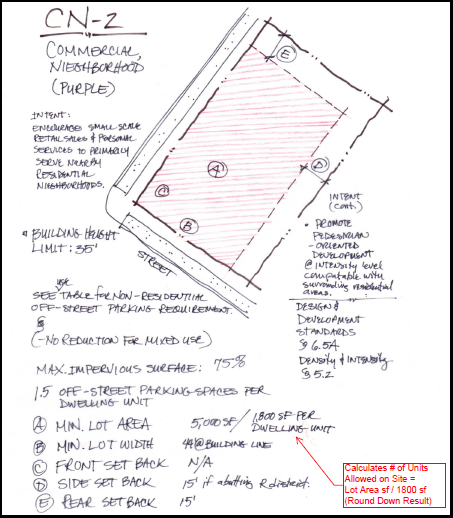 “Let’s make car storage the primary function of our city!” exclaims absolutely no one ever. Unfortunately, the zoning code does. Which is why most cities say they want walkability, but require a ridiculous amount of off-street parking.
“Let’s make car storage the primary function of our city!” exclaims absolutely no one ever. Unfortunately, the zoning code does. Which is why most cities say they want walkability, but require a ridiculous amount of off-street parking.
In our case, each one-bedroom unit required 1.5 off-street parking spaces. Thus, our three apartments needed five total parking spaces (of course, you have to round up). The commercial parking requirements were even worse. It was a moving target based on “use.” Would the commercial space be used as offices? Retail? A coffee shop, restaurant or bar? How could we even know? (None of us brought a Magic 8 Ball to the workshop.)
DOING THE MATH…
The commercial off-street parking requirements ranged from one space per 330 square feet of office floor area to one space per 100 square feet of restaurant. At a minimum, we would be required to provide 7 parking spaces for our 2,400 SF of commercial space. If a tenant wanted to use this space for a bar, we would need 24 parking spaces—because drinking and driving is oddly enshrined in most zoning codes.
All together (calculating residential and commercial) we would need parking for 11 to 29 cars for our little building. And since it takes about 300 SF of land for every parking space (which includes the stall plus associated drive aisles) we would need between 3,300 and 8,700 square feet of land dedicated solely to parking.
Did I mention that our parcel was only 6,752 SF? And we wanted to include a building?
After a lot of sketching and scratching of heads, we managed to fit our building and 10 parking spaces on the lot. Close, but no cigar in our attempt to fulfill the requirements of the zoning code and build “by right.” In real life, that single space we lacked would require a trip to the Board of Adjustment to beg for a variance.
I’LL TAKE PARKING FOR 100, ALEX…
Our story is not unique. Throughout the country, you’ll find zoning codes quite similar to those in Kalamazoo. Because it’s expensive and tedious to overhaul zoning ordinances, they tend to fossilize over time. Unfortunately, many of them appear to be trapped in a geologic formation that includes beehive hairdos, transistor radios, and the 22-volume 1971 World Book Encyclopedia.
Thus, zoning ordinances still require off-street parking to “lessen congestion in the public streets” as if promoting auto travel is a scientifically proven method for eliminating traffic. And while some cities are beginning to reduce off-street parking ratios, only a brave minority have taken the plunge to eliminate them altogether.
So even if those parking spots aren’t needed, they are required. Which basically sucks for everyone except the guy who lays the asphalt. It limits the ability of developers to build small-scale infill projects that contribute to walkable neighborhoods. It incentivizes driving, while punishing people who walk, bike and use transit. And it dilutes property tax revenues because asphalt is never the highest and best use of land.
You’d think this problem would be easy to fix. But if you’ve ever doubted that the pen is mightier than the sword, just try to change a few words in your local zoning code. People will show up in force to protect the status quo as if defending against a zombie apocalypse.
Which is funny, because most folks don’t have a clue what the zoning code actually says or how it impacts their daily lives.
Reading your local zoning ordinance is a powerful soporific; it will induce sleep faster than a Benadryl with bourbon. But it is also, literally, the law of the land—a regulatory document that determines how buildings, neighborhoods and cities will evolve over the coming decades.
If you care about your city’s future, you care about the zoning code.
If we want that future to include small-scale, incremental development that creates walkable places, while building local wealth and improving traditional neighborhoods, we need to make sure our zoning codes enable that vision.
It might be time for a review. Grab a coffee and a copy of your zoning code, and get busy!
Read More